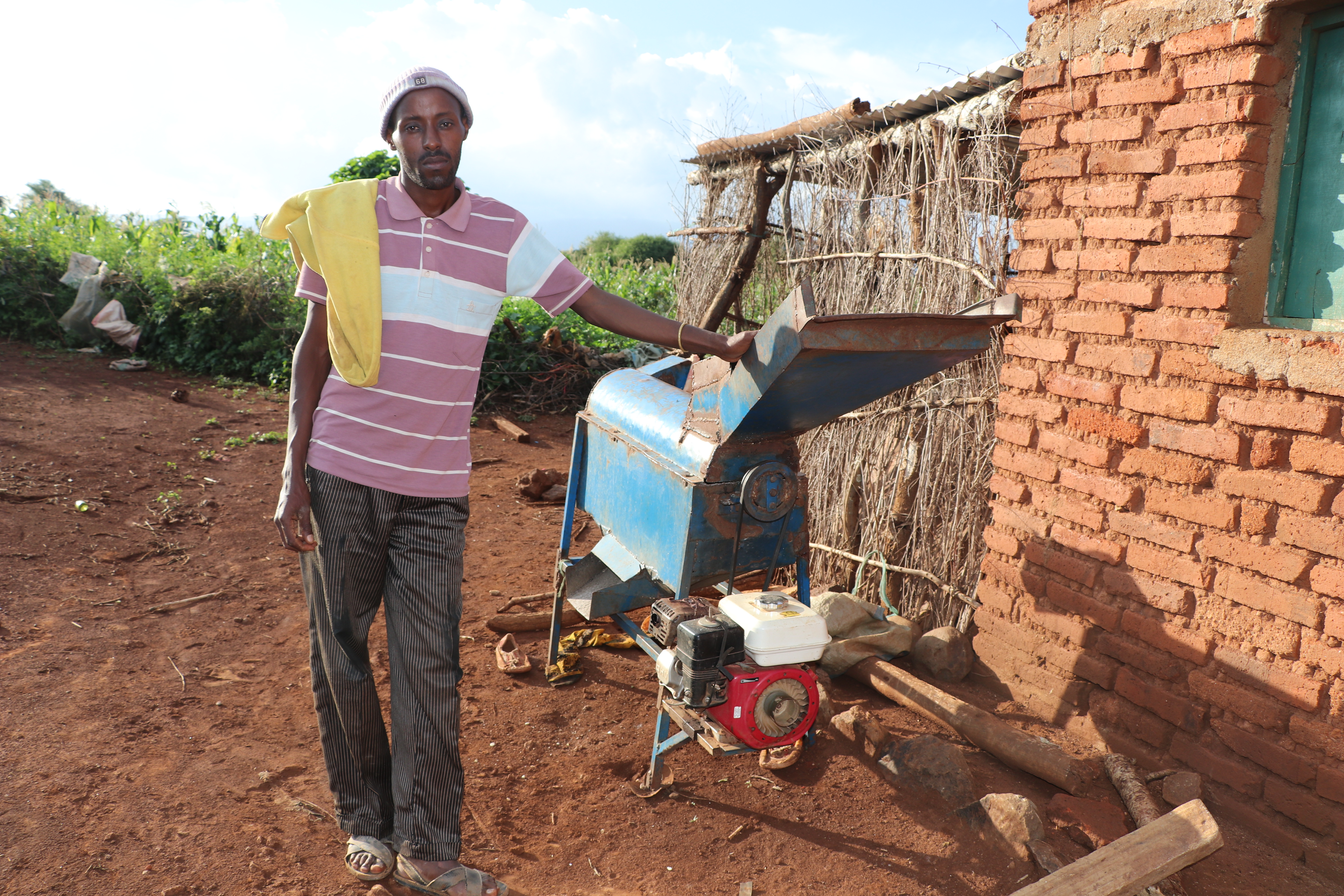Africa RISING–Islands of Peace partnership: A portrait of success from a Tanzanian smallholder’s point of view
For smallholder farmers like Michael Lahoya from Changarawe village, in Karatu District, Northern Tanzania, agriculture is their main source of livelihood. This father of five depends on agriculture primarily for food for his family and then secondarily for income when he sells the surplus to customers who buy maize straight from his farm. Since 2009, Lahoya has been cultivating onions and maize on his one-and-a-half-acre farm. But in 2016, he changed tack, opting instead to focus his farming on maize production, which he felt offered better returns.
Although maize production assured him of food and a better income, post-harvest processing of the crop remained a challenge. Right from harvesting, to transportation, to shelling and storage of the harvested crop; Lahoya has always had to hire labour and often loses a significant portion of his harvest during shelling and storage.

‘I have tried different methods to process harvested maize from my farm like using a tractor to crush the maize cobs during shelling, to putting the cobs in a bag, and then beating with it a stick. However, none of these methods ever gave me satisfactory results until in 2018 when I was introduced to modern techniques for improved postharvest handling of my maize harvests,’ says Lahoya.
A study by Africa RISING scientists shows that smallholder farmers in Tanzania lose nearly 60% of their harvests during pre-and postharvest operations. Quantitative post-harvest losses of economic importance occur in the field (15%); during processing (13–20%), and during storage (15–25%).
In 2018, the Africa RISING project partnered with the Belgian non-governmental organization, Iles de Paix /Islands of Peace (IoP), to improve the capacity of farmers in Karatu District in postharvest management of cereals as an entry point to improved livelihoods. Through this collaboration, Africa RISING scientists provided technical backstopping to IoP’s developmental work with research data for the introduction and use of mechanized maize shelling machines, hermetic storage bags, and silos by the farmers.
After taking part in some of the training sessions, Lahoya decided to give the technologies a try, opting to purchase one of the mechanized maize shelling machines for TZS700,000 (USD305).
‘After consultations with one of the technicians from the project; I saw great potential in acquiring the maize sheller, which in addition to helping me in my farm, I could also rent out at a small fee to my fellow farmers in Changarawe Village. I didn’t have the money, so I went and borrowed money from one of my friends. That was at the end of April 2016. Since then, this machine has turned into another source of income for me!’ explains Lahoya. ‘I now provide maize shelling services to farmers in other villages like Endashangwe,’ he adds.
He provides shelling services to his fellow farmers at an affordable cost of between TZS1,000 to 1,500 per bag. The price varies depending on the moisture content of the maize received for shelling.
‘Acquiring the shelling machine has turned out well. In August 2016, I shelled 1,104 bags of maize earning a total of TZS1,104,000. This allowed me to quickly repay the loan from my friend within the same year!” notes Michael.
For each year since, Lahoya has earned an average of TZS1,500,000 from his shelling business.
‘Well, each year I shell about 1,000 bags of maize. In 2020 and 2021, I shelled 2,000 bags of maize and earned three million shillings,’ he says. Lahoya considers maize shelling to be a profitable ‘part-time’ business because he mostly must wait until the harvesting season to engage in it.
To diversify his income streams from the shelling enterprise, he sometimes also buys unprocessed maize at the cost of TZS42,000 from fellow farmers and resells it after shelling at a cost of TZS56,000 per bag. For example, in 2019, he processed and sold 11 bags of maize through this initiative. Because of some challenges in 2020, he bought only nine bags of maize at TSZ42,000 and sold them at TSZ56,000 TZs per bag after shelling. Thanks to the improved income from the maize shelling service, in May 2020, Lahoya says he has started the construction of a permanent house for his family.
Besides the mechanized maize shelling, he also uses other postharvest technologies promoted by Africa RISING and the IoP project such as the hermetic bags to store his maize grains. A hermetic storage bag retails for TZS5,000 at the local AgroVet store near Changarawe Village.
The sound of a mechanized maize shelling machine being operated may sound noisy to most, but ‘that sound is music to my ears!’
‘Every time the machine is running, I know that I have gained a little more income. This little machine has provided me with additional income to feed my family and cater for their needs,’ he says with a smile.
‘Technologies such as PICS bags and maize shelling machines are quite good. For example, a farmer can use a PICS bag to store maize grains safely without fear of interference from pests for at least four years. Many farmers are also continuing to adopt the technology after witnessing the benefits some of us are deriving from them,’ he adds. The Africa RISING-IoP intervention ended in December 2020 having reached nearly 1,400 smallholder farmers like Michael Layoya in Karatu District with improved postharvest technologies. Africa RISING works with developing partners to scale out best-bet technologies validated through research to farming communities.






Latest Comments